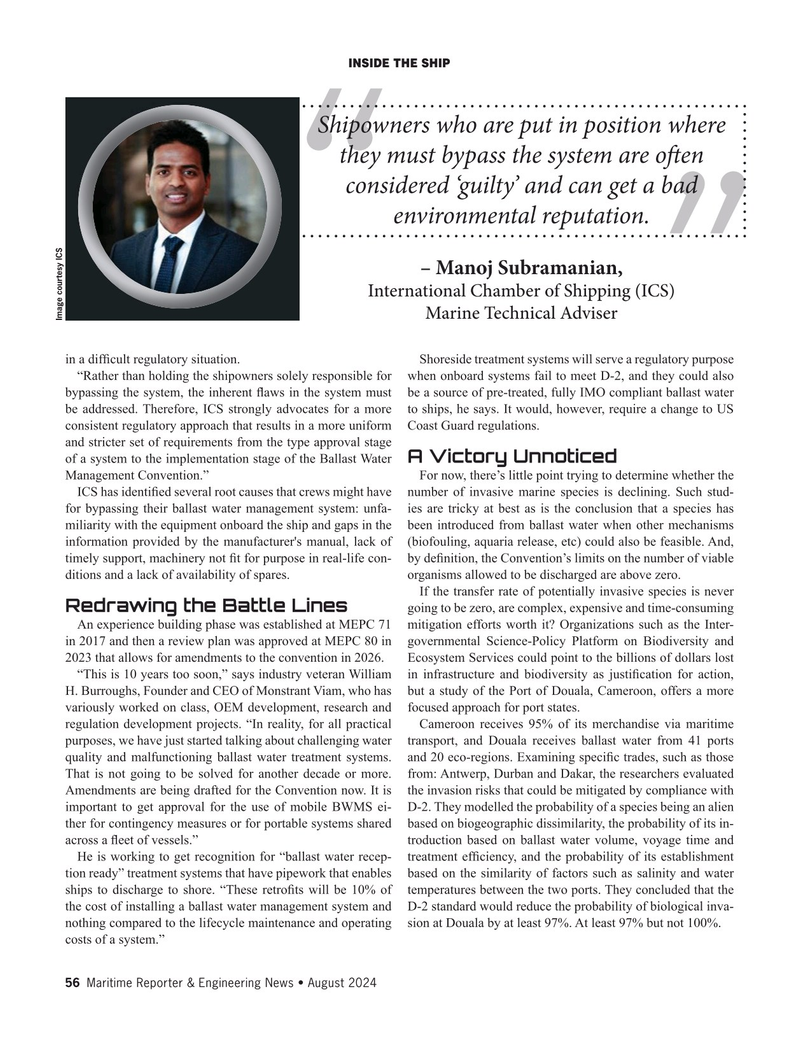
Page 56: of Maritime Reporter Magazine (August 2024)
Read this page in Pdf, Flash or Html5 edition of August 2024 Maritime Reporter Magazine
INSIDE THE SHIP
Shipowners who are put in position where they must bypass the system are of en considered ‘guilty’ and can get a bad environmental reputation.
– Manoj Subramanian,
International Chamber of Shipping (ICS)
Marine Technical Adviser
Image courtesy ICS in a dif? cult regulatory situation. Shoreside treatment systems will serve a regulatory purpose “Rather than holding the shipowners solely responsible for when onboard systems fail to meet D-2, and they could also bypassing the system, the inherent ? aws in the system must be a source of pre-treated, fully IMO compliant ballast water be addressed. Therefore, ICS strongly advocates for a more to ships, he says. It would, however, require a change to US consistent regulatory approach that results in a more uniform Coast Guard regulations. and stricter set of requirements from the type approval stage of a system to the implementation stage of the Ballast Water A Victory Unnoticed
Management Convention.” For now, there’s little point trying to determine whether the
ICS has identi? ed several root causes that crews might have number of invasive marine species is declining. Such stud- for bypassing their ballast water management system: unfa- ies are tricky at best as is the conclusion that a species has miliarity with the equipment onboard the ship and gaps in the been introduced from ballast water when other mechanisms information provided by the manufacturer's manual, lack of (biofouling, aquaria release, etc) could also be feasible. And, timely support, machinery not ? t for purpose in real-life con- by de? nition, the Convention’s limits on the number of viable ditions and a lack of availability of spares. organisms allowed to be discharged are above zero.
If the transfer rate of potentially invasive species is never
Redrawing the Battle Lines going to be zero, are complex, expensive and time-consuming
An experience building phase was established at MEPC 71 mitigation efforts worth it? Organizations such as the Inter- in 2017 and then a review plan was approved at MEPC 80 in governmental Science-Policy Platform on Biodiversity and 2023 that allows for amendments to the convention in 2026. Ecosystem Services could point to the billions of dollars lost “This is 10 years too soon,” says industry veteran William in infrastructure and biodiversity as justi? cation for action,
H. Burroughs, Founder and CEO of Monstrant Viam, who has but a study of the Port of Douala, Cameroon, offers a more variously worked on class, OEM development, research and focused approach for port states. regulation development projects. “In reality, for all practical Cameroon receives 95% of its merchandise via maritime purposes, we have just started talking about challenging water transport, and Douala receives ballast water from 41 ports quality and malfunctioning ballast water treatment systems. and 20 eco-regions. Examining speci? c trades, such as those
That is not going to be solved for another decade or more. from: Antwerp, Durban and Dakar, the researchers evaluated
Amendments are being drafted for the Convention now. It is the invasion risks that could be mitigated by compliance with important to get approval for the use of mobile BWMS ei- D-2. They modelled the probability of a species being an alien ther for contingency measures or for portable systems shared based on biogeographic dissimilarity, the probability of its in- across a ? eet of vessels.” troduction based on ballast water volume, voyage time and
He is working to get recognition for “ballast water recep- treatment ef? ciency, and the probability of its establishment tion ready” treatment systems that have pipework that enables based on the similarity of factors such as salinity and water ships to discharge to shore. “These retro? ts will be 10% of temperatures between the two ports. They concluded that the the cost of installing a ballast water management system and D-2 standard would reduce the probability of biological inva- nothing compared to the lifecycle maintenance and operating sion at Douala by at least 97%. At least 97% but not 100%.
costs of a system.” 56 Maritime Reporter & Engineering News • August 2024
MR #8 (50-65).indd 56 8/8/2024 4:08:00 PM

 55
55

 57
57
